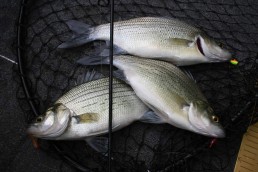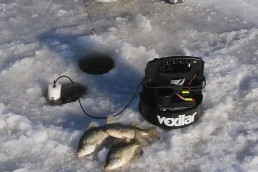Whites and Wipers are Running Now
SHARE THIS POST
If you like catching a pile of fish and cleaning and eating them, white bass are for you. White bass and wiper runs are on all the major Midwest rivers and power-plant lakes now, and it’s your duty to catch them. There are notorious runs on the Fox, Mississippi, Illinois and Wisconsin rivers, and these bass will pile up shallow in tributaries and spawning flats. In lakes that have healthy white and wiper populations, spring is the easiest time to catch them with the right tools and techniques.
Whippin’ and rippin’ blades
Blade baits like B-Fish-N B3 and Big Dudes play a big part in catching these aggressive fish. Because they school up, competition is fierce. These voracious fish will engulf large, flashy blades that imitate minnows. The best part is the strike where a 1-pound fish will nearly rip the rod out of your hand. We like to use our baitcasting bass rods spooled with 14-pound McCoy Mean Green line. This is a tough mono, which you’ll need when casting 1/2-ounce blades around obstructions like fallen trees and rocky areas. A good, stout rod with a fast tip like a St. Croix Mojo Bass is ideal.
These blades sink fast and you have more control with baitcasting gear. Wing the blade out and stop it with a little finger pressure on the spool before the blade hits the shore and begin reeling fast, before it snags shallow. You can slow your retrieve as you bring the bait in or add a stop-and-go action. When a fish hits, set the hook hard, crank fast, and then slow down to enjoy the fight. We bring a good supply of colors along because the fish will prefer brighter colors at brighter times and darker colors and glows in low-light conditions. But if Poppee had only one color to choose, it would be gold.
Doubling-up on feathered jigs
Feathered jigs have flash and attraction that whites and wipers love—the feathers flatten out when pulled forward and then fluff up on the pause or rest. We like to double- and triple-up our presentations with feathered jigs by tying up multiple jig rigs. The first way would be to attach a barrel weight to the end of your line and add two to three dropper lines up ahead, usually with 1/16-ounce jigs up the line. You can use three-way swivels or loop knots. Depending on state regulations, you can have two or three jigs on your line. The second method is to use a 1/4-ounce feathered jig on the bottom and two 1/16-ouncers up above. You can tip the jigs with minnows or use “as is,” when the fish are aggressive. We like the Flu-Flu jigs, as they’re well built and won’t fall apart after multiple catches and come in a variety of colors.
Are you enjoying this post?
You can be among the first to get the latest info on where to go, what to use and how to use it!
There is a multitude of ways to fish these rigs: a vertical jig, toss and bounce off the bottom or let them sit in the current rigged with minnows. Often, you can catch two or three fish on the same rig and reel them in slowly when you catch one so it can attract another to grab the other jig.
Vertical jigging
Poppee’s favorite way to catch whites is by vertical jigging; he figures that the longer his bait is in the water, the better chance he has to catch one. Poppee prefers the lightest jig he can get away with and sometimes he adds plastic, sometimes a minnow. Either way, he tosses the jig behind the boat, waits for the slack and starts jigging and slowly reeling until the jig is under him.
B-Fish-N H20 jigs are the way to go in this situation. These are streamlined to handle the current and have a keeper built in the head to hold the plastic, which in Poppee’s case, is two new AuthentX colors we tested last fall in the 2.45-inch Pulse-R family: Fire Ice White and Watermelon with a Chartreuse tail.
Whether you fish from shore or boat, the time is now for the white bass and wiper runs. Be prepared with a few great lures, stout tackle, a cooler full of ice and a sharp knife for filleting.
MWO
SHARE THIS POST
Did you enjoy this post?
You can be among the first to get the latest info on where to go, what to use and how to use it!
Walt Matan
Walt Matan has been a writer and television host for MidWest Outdoors for 30 years. An avid ice and open-water fisherman, he currently lives in the Quad Cities on the shores of the Mississippi River. He is the product developer and brand manager for Custom Jigs & Spins, B-Fish-N Tackle, and Rippin Lips Catfish Tackle. For more information visit customjigs.com.



